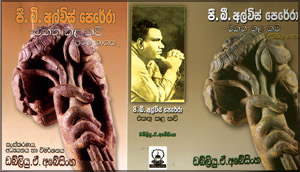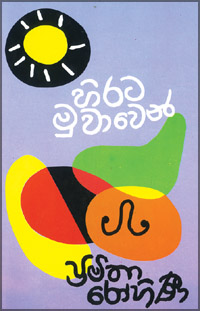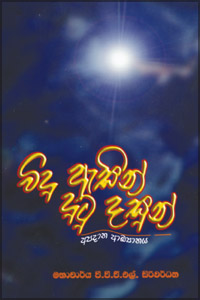|

Fitting tribute to eminent Sinhala poet and critic
P. B. Alwis Perera - Ekatukala Kavi (Collected Poems of P. B. Alwis
Perera)
Volume I and Volume II
Edited with an introduction by W. A. Abeysinghe
Samayawardana Bookshop (Pvt) Ltd, Colombo 10.
Review: Kivipathi, Kalasoori Dhanapala Nissanka
 POETRY: 'P. B. Alwis Perera' was once a household name. Many knew him
as a poet with great creative talents and also as a genius who could
recite beautiful and meaningful extempore verses. POETRY: 'P. B. Alwis Perera' was once a household name. Many knew him
as a poet with great creative talents and also as a genius who could
recite beautiful and meaningful extempore verses.
Whenever he was participating in a 'kavi maduwa' with his
contemporaries such as U. A. S. Perera, H. M. Kudaligama, John Rajadasa,
Meemana Premathilaka et al, their fans were so enthralled that they
scrambled at the gates of halls where such poetical debates were held
(mostly at YMBA, Borella) to catch a glimpse of them. He could keep an
audience spellbound for hours with his witty 'hitiwana kavi' recited
with great aplomb.
His writings too were exceptionally outstanding. His vocabulary, flow
of thoughts, language and style were inimitable. In selecting words and
infusing smoothly colloquial language with that of the written, P. B.
Alwis Perera (PBA) surpassed all his contemporaries. He was equally
popular among intellectuals as well as the hoi polloi.
In 'Nawa Padya Sinhalaya', Martin Wickramasinghe says that Alwis
Perera's thoughts are like a waterfall which never runs dry.
May be due to the inability of some academics and intellectuals in
his day to deliver in the manner he did, he became the subject of their
bitter criticism.
They reduced his works into smithereens. It can be described more as
a campaign of persecution against him, far from being an impartial
unbiased criticism, which no doubt is acceptable as an essential
component of any developing literary culture.
Grateful individual
While the name Alwis Perera was fading away and was gradually being
relegated to insignificance, a grateful individual who knew and well
conversant with his works has brought it back to the forefront.
That individual is none other than the veteran journalist, author,
critic and most importantly lyricist turned poet of Kolamba Yugaya, W.
A. Abeysinghe (WAA). He had done this in the form of producing a pair of
massive volumes of anthology containing PBA's works. Fifteen thousand of
them! As it had been impracticable to include such a large number of
works in a single volume, WAA has probably decided to divide them
between too volumes.
However, even after adopting such a strategy, he had not been able to
prevent each volume exceeding thousand pages. It had been a herculean
task indeed. The great pains he had taken and the midnight oil he may
have burnt to produce these mammoth publications defy imagination. It is
also significant that launching of this pair of volumes coincided with
the 90th birthday anniversary of the great poet.
Unlike most of his contemporaries, PBA was not only a poet, but also
a politician, social reformist, orator and literary critic. The two
volumes amply reflect all these attributes.
In 'Pilisandara', WAA says that there is no other poet who had fallen
victim to an organised cruel attack of criticism like Alwis Perera. Yet
with a sense of forgiveness and magnanimity, WAA says that the best
monument we can erect now for PBA who fell victim to a harsh historical
injustice, is to offer his creative resources to the younger generation,
rather than to get involved in a critical controversy, the time for
which is, now too late.
Magnum opus
In volume I, in a lengthy foreword, WAA makes a very realistic and
comprehensive appraisal of PBA's works. It can prove very informative
and useful to the student of literature. Thereafter, almost all the
works of PBA have been lined up in a systematic order.
PBA has nearly fifty books to his credit of which his magnum opus, I
believe, is 'Anura Seenaya'. All these verses are included in the two
volumes including the Kasa Pahara (whip strokes) in which PBA had
'flogged' whoever who committed an act inimical to that day society, in
his celebrated monthly poetry periodical Dedunna (Rainbow).
In her insertion at the tail end of volume II, Chitra I. Perera, the
only daughter of PBA who herself is a poet and author and who according
to WAA was the strength behind him in the compilation of the two
volumes, going down the memory lane, kindles the curiosity of the reader
with graphic descriptions of various anecdotes about her beloved father.
Both volumes of Alwis Perera, identical like twins, in size, shape
and appearance are elegantly finished in hardback with additional
protective paper-backs. Each volume is priced at Rs. 1,500. Nevertheless
they are worth more even when their outer appearances alone are
considered, leaving alone the qualitative value of the contents.
The two volumes of 'P. B. Alwis Perera's Collected Poems' will
certainly adorn a library. They are a must for all those who have a
taste for traditional poetry. Those who have an interest in Sinhala
poetry owe WAA a debt of gratitude for the arduous work he had
undertaken to produce these two volumes simultaneously in a masterly
manner, perpetuating the name of a great poet - a national wealth of
ours.
The reviewer is the author of five poetry books, including the
biography of Alwis Perera.
Creative writer in the making
Hirata Muwawen
Author : Pramitha Rohini
Publishers : S. Godage and Brothers, Colombo 10
pp 138
Price: Rs. 225
Review: E.M.G. Edirisinghe
 PROSE AND POETRY:Hirata Muwaven by Pramitha Rohini is basically a
balanced blend of prose and poetry. It is her maiden effort as a
creative writer. PROSE AND POETRY:Hirata Muwaven by Pramitha Rohini is basically a
balanced blend of prose and poetry. It is her maiden effort as a
creative writer.
As a poet and a prose writer Pramitha shows her latent talents with
an immense capacity. She comes out with a striking creative work. Any
reader will enjoy reading it effortlessly. The easy-paced compositions
will take him to a plane of novel experience.
The writer appears to have drawn heavily from her life's experiences.
This is a literary work replete with originality.
In contrast to her prose her poems reflect altogether a different
aspect of her experience. Her poems embody inspiring scenes of nature
and beauty that envelop rural life with which she is very familiar.
This duality in her work portrays the bitterness of her encounters in
living the life of a woman at home and the soothing effect of the nature
and the refreshing air she breathed within a rural atmosphere.
Poetic effort
This work in its entirety is a poetic effort to project bitter and
harsh experience one gains in one's routine life. "Nendamma"
(mother-in-law) is a short story where she describes the simmering
animosity that surfaces in a mother-in-law who unconsciously and
indirectly develops a dislike against her daughter-in-law who she thinks
has robbed the love and affection of her son.
The writer's vision of life though simple is pragmatic.
The author's personal experience in the social, religious and
academic sphere, has induced her to translate her random thoughts into
poetic and prose versions.
Sentiments
Her description of situations and events together with accompanying
sentiments are full of emotions and are couched in clear linguistic
compositions. Sometimes she shows characteristics of a mature creative
wrier.
Her poetic impressions are more eloquent than prose compositions. She
possesses the talent that could be expanded and refined if she continued
to write.
Masking the demons and personification of spirits
Masks of Sri Lanka and Mask-and Kolam Dancing
Author: R. C. de S. Manukulasooriya
Publication sponsored by the Ceylon Branch of the Royal Asiatic
Society 142 pp.
Review: Carl Muller
MASKS: The moon is sliced thin and the darkness is punctured by naked
torchlight. Sanni and Gara demons appear, treading the smooth-sand floor
and there rises the frenzy of drums.
This, says the author, is but a small wedge of a large belief in the
dance of the demons. He introduces readers to the age-old use of masks
and mask dancing that is found in many lands: India, Africa, Malaysia,
Tibet, Thailand and Northern America.
The masks are as ceremonial disguises, used the world over, each land
calling upon the intervention, or making obeisance to its many gods. As
the author says: ...masks and mask dancing take various shapes and forms
and embody many of the local beliefs of the inhabitants.
Touching on Kolam Natuma, he tells of its original form as a fully
conventionalised ritual that, in recent times, has come to be associated
with rustic humour. There is the highest social group - kings, queens,
ministers, soldiers, etc., and there is also the country bumpkin,
musicians, peasants, excellent caricatures of a Negro woman, the
European, the money-lender, etc.
What is so engrossing is the elaborate manner in which the large,
virtually pop-eyed masks are worn: the king with his light-wood mask
intricately carved with headgear like an upturned beaker; the queen with
her brightly-painted till-like headdress.
There have been many different masks for the king, some even bearing
outer flaps on which rear the lion and the unicorn - royal beasts of the
British, although the face is framed in a manner reminiscent of old
Egypt. Clearly, some masks were created during British times, and yet,
the Sinhala lion takes centre stage, beautifully carved into the
headpiece.
Elaborate masks
Ministers were depicted with less elaborate masks, while princes
carried domes headdresses from which spirits with down-turned mouths
frowned fiercely. What is so wonderfully represented, as the author
shows, is the characterisation, so artfully captured in the carving of
each mask.
The Mudaliyar is fat-cheeked, bulbous-eyed and with a most insincere
mouth. The Englishman is long of nose, small of forehead and even the
10th century side-burns are painted in.
The Chetty wears his pie-dish hat and a toothy grin below his curved
moustache tells that he cannot be trusted. As the author explains: ...
the term KOL has been used in the sense of distortion or caricature in
the Jataka Athuwa Getapadaya. The characters in kolam are not
individuals but broad types... most of the exponents of the kolam dances
possess almost a complete set of the masks required for the exposition
of the kolam dances.
Many of them are experts in their particular field of activity.
Collectively, a set of masks required for an exposition is called a
kolam kuttama, some of which may have been in the family for many years
and passed from father to son (that they) continue the expositions in
(an) unbroken tradition.
Introducing us to demon masks, the author details the three-groups -
Rassa, Sanni and Gara as well as masks of the spirits of animals: lion,
bull, wolf, dog, leopard and jackal - and mythical figures such as the
kindura and kinduri. What makes this book both illuminating and
scholarly is the large section of print. The author offers a 19th
century spectrum of masks now in the Berlin Museum of Folk Art, the Daha-Ata
Sanni masks, masks used in Raksha and Gara Yak dances; in Palapali
dances; a host of miscellaneous masks and costumes; as well as a detail
of the masks in the collection of the Colombo National Museum.
The demons, naturally, are propitiated, summoned or cast forth. The
Sanni demons are brought forth to receive offerings and dispel sickness,
even madness; while the Gara demons are worshipped as they who serve the
Gara Yaka. In their ranks are the female demons - the blue giri; the
joyous; the dancing giri. They are good-natured, and as Manukulasooriya
says: (lean) towards human beings and are worshipped at various
ceremonies.
Carved masks
We are also given much detail on the making of masks. This, in
itself, is a call for study. As the author says: The time-honoured way
(in the adornment of the carved masks) was by the use of vegetative
material. (Today, natural pigments have given way to imported oil-and
lacquer paints, but in the early 19th century) green was obtained from
Kikirindiya... ranawara... or the Ma creeper... while black was obtained
from the soot of burnt cotton or cloth. Blue was obtained from the ripe
fruit of the Bovitiya.. red... from cinnabar, and yellow from the
Hiriyal or yellow orpiment... The mask was varnished with Valicci made
from resin from the Hal tree... or the oil from the Dorana tree....
He adds that embellishments such as eyebrows, moustaches and boards
were made from monkey-skin. The hair was made from the fibres of the
Niyanda....soaked in water, beaten, dried, combed and dyed....
It is a pity that, as the author states, no proper survey has been
done to record where masks are available and to ascertain their age.
Most of the earliest masks found their way to ethnological museums in
Stockholm, Hamburg, London, Copenhagen, the Prague and Munich. The only
single collection of dancing masks we have local claim to is in the
Colombo National Museum.
It is remarkable that Mr. Manukulasooriya has given us an overall
portrayal of masks and mask dancing in the space of just 14 pages, but
he has wisely left the rest of his work to photographs and
illustrations. And yet, in this short space, he has covered a subject
that is so absorbing.
We learn that in the days of the Kandyan kings, the Bamba led the
procession of the devales at the Esala Perahera - the Bamba or Maha
Bamba being a man in total disguise, transformed as in the
representation of the Maru Sanni Yaksaya, with no mask but with false
protruding teeth and the application of coconut oil mixed with soot on
face and limbs.
All in all, this is an important and very informative book, prepared
with much learning and research. Mr. Manukulasooriya deserves much
applause and I have little doubt that the "Masks of Sri Lanka...." will
be reached for by students, dramatists, and all who wish to know of what
the mask art and culture of this island is all about.
Memories and Reflections: abridged version in Sinhala
Vidu Asin Dutu Dasun
Author: Prof. P. P. G. L. Siriwardene
 AUTOBIOGRAPHY: Vidu Asin Dutu Dasun is the Sinhala version of
Professor P. P. G. L. Siriwardene's autobiography entitled, 'Memories
and Reflections'. However, Vidu Asin Dutu Dasun is not really a direct
Sinhala translation of the original work. AUTOBIOGRAPHY: Vidu Asin Dutu Dasun is the Sinhala version of
Professor P. P. G. L. Siriwardene's autobiography entitled, 'Memories
and Reflections'. However, Vidu Asin Dutu Dasun is not really a direct
Sinhala translation of the original work.
It is an admirably abridged presentation of the original which is
quite accurate and highly readable. In fact, it could be considered as
an encapsulated form of Professor Siriwardene's autobiography, expressed
eloquently in the Sinhala idiom.
Exemplary character
This is an instructive book which depicts the development of an
exemplary character, from early childhood to the post-retirement period
of a remarkable individual. On finishing the book, the feeling that one
gets is that this professor is a unique university academic who has
grown into legendary proportions in his own lifetime.
It must also be said that at certain places the book appears to be an
exciting, informative and refreshingly entertaining, travelogue of
global dimensions, the journeys of which were undertaken for serious
academic purposes.
It is not surprising that the present volume contains an enviable
catalogue of brilliant achievements and well deserving appointments to
prestigious positions at the national and international levels. The
reason for one not being surprised at all in this regard is that
Professor Siriwardene is not a mere individual, but a whole institution!
In chapters 16 and 17 of the book, the reader will encounter two of
the most significant events of Professor Siriwardene's illustrious
career.
Majestic photograph
One was heralded in the Sunday Observer of December 7, 1975 with the
front page banner headline, 'A big man for a big job'. It was adorned
with a highly expressive majestic photograph very appropriate for that
particular headline (see pages 113 and 114 of the book).
The other event which happened on January 1, 1979 is unemotionally
recorded in low profile on pages 125 and 128 of the book. However, even
by cursorily glancing through the pages, one could infer that this 'Big
man', this gargantuan academic-technocrat-administrator, was deposed
from his position of the Vice Chancellor of the mega-university of six
campuses by an act of omission.
The unique Vice-Chancellor was unceremoniously forced to go back to
his old Chair of Chemistry at the University of Colombo!
JKPA |

